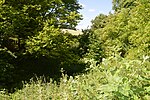St Paul's Walden Bury

St. Paul's Walden Bury is an English country house and surrounding gardens in the village of St Paul's Walden in Hertfordshire. The house is a Grade II* listed, and the gardens Grade I. A home of the Bowes-Lyon family, it is possibly the site of the birth of Queen Elizabeth, the Queen Mother.The garden wilderness, or highly formalized woodland, is a very rare survival, and the "most perfect surviving" English example. It was laid out in the 1730s with straight walks in the old formal style, when these were already becoming rather unfashionable.The house, of red brick with stone dressings and slate roofs, was built around the 1730s for Edward Gilbert (1680–1762). His daughter Mary married George Bowes of Gibside, Durham, and the estate has been in the possession of the Bowes or Bowes-Lyon family since 1720. James Paine made alterations to the house in the 1770s, which was also extended to the rear in the late nineteenth century.
Excerpt from the Wikipedia article St Paul's Walden Bury (License: CC BY-SA 3.0, Authors, Images).St Paul's Walden Bury
Narocz, Warschau Mokotów (Warschau)
Geographical coordinates (GPS) Address Nearby Places Show on map
Geographical coordinates (GPS)
| Latitude | Longitude |
|---|---|
| N 51.881111111111 ° | E -0.27611111111111 ° |
Address
Fort VIIA Twierdzy Warszawa "Służewiec"
Narocz
02-678 Warschau, Mokotów (Warschau)
Woiwodschaft Masowien, Polen
Open on Google Maps









